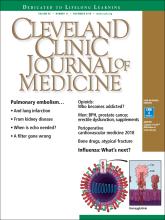Article Figures & Data
Tables
Parameter PESI scoring Simplified PESI Age Age in years 1 point if age > 80 Male sex 10 points — Cancer 30 points 1 point Heart failure 10 points 1 point Chronic pulmonary disease 10 points 1 point Pulse ≥ 110 bpm 20 points 1 point Systolic blood pressure < 100 mm Hg 30 points 1 point Respiratory rate > 30 per minute 20 points — Temperature < 36°C (96.8°F) 20 points — Altered mental status 60 points — Arterial oxyhemoglobin saturation < 90% 20 points 1 point Risk stratification Total points Total points PESI ≤ 65 Class I Very low (0%–1.6%) 66–85 Class II Low (1.7%–3.5%) 86–105 Class III Moderate (3.2%–7.1%) 106–125 Class IV High (4.0%–11.4%) > 125 Class V Very high (10.0%–24.5%) Simplified PESI 0 1.0% ≥ 1 10.9% Based on information in references 2 and 3.
- TABLE 2
Bova scoring system for estimating 30-day risk of complications or death in acute pulmonary embolism
Predictor variable Points Systolic blood pressure 90–100 mm Hg 2 Elevated cardiac troponin 2 Right ventricular dysfunction on echocardiography or computed tomography 2 Heart rate ≥ 110/min 1 Points a Stage 30-day risk of complicationsa 30-day risk of death 0–2 I 4.4% 3.1% 3–4 II 18% 6.8% > 4 III 42% 10% ↵a The Bova score predicts the 30-day risk of complications and death in hemodynamically stable patients. Complications include hemodynamic collapse and recurrent nonfatal pulmonary embolism.
Based on information in reference 4.
Pulmonary embolism severity index (PESI) class III to V, or simplified PESI score ≥ 1 Right ventricular dysfunction or strain on computed tomographic angiography Sinus tachycardia (heart rate > 100 beats per minute) Persistent bradycardia (heart rate < 40 beats per minute) Elevated cardiac troponin or N-terminal pro-B-type natriuretic peptide New complete or incomplete right bundle branch block Changes in anteroseptal ST segment or T wave






